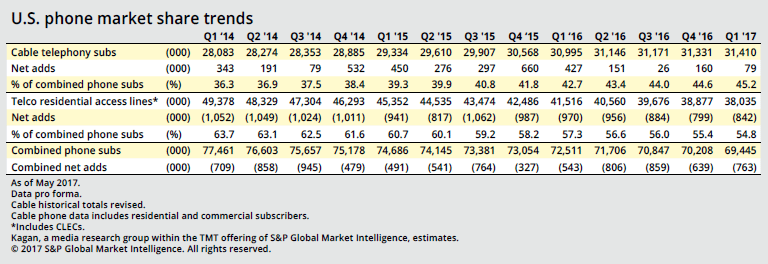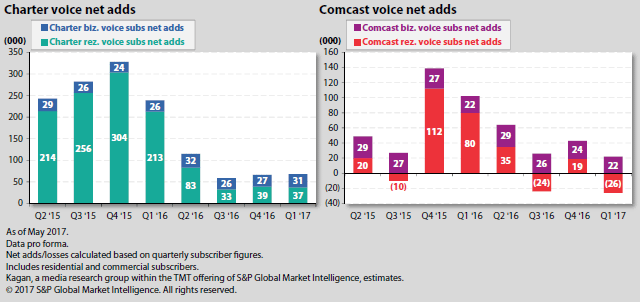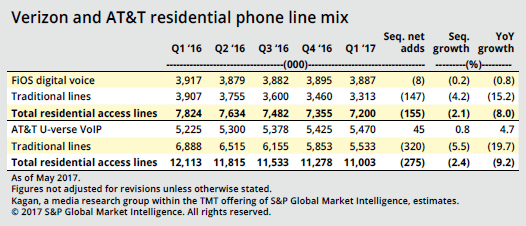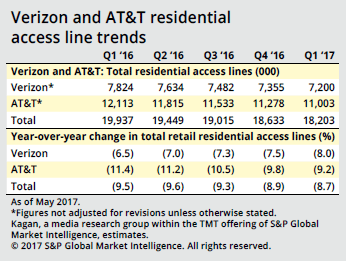circuit switched voice
Wireline Phone Losses Continue into 1stQ-2017; Telco VoIP >PSTN Subscribers
By Chris Young and Kamran Asaf of SNL Kagan
Losses in wireline phone subscribers picked up steam in the first quarter of 2017 as a lackluster performance by cable operators failed to offset declines from telcos. According to company reports and estimates from SNL Kagan, a media research group within S&P Global Market Intelligence, wireline phone providers lost 763,000 subscribers in aggregate during the quarter, a 40% steeper drop than the loss experienced in the first quarter of 2016.
Cable’s share of the shrinking sector creeped up to 45.2%, 2.5 percentage points over the year-ago quarter.

New commercial subscriber information released by Comcast allows us to delve deeper into the segment. As expected, commercial services boosted cable’s voice segment as residential uptake falters. In some quarters, commercial voice gains offset declining residential voice losses at the operator.

Charter is not immune to declining net additions. The operator’s voice net adds dipped considerably since closing its Time Warner Cable Inc./Bright House Networks LLC acquisitions. The operator faces a tough task overcoming churn at legacy Time Warner Cable systems, in part driven by its low-priced promotional voice offering in prior-year quarters.
Both Charter and Comcast are actively looking to deploy wireless telecom services by activating their mobile virtual network operator agreements with Verizon Communications Inc.‘s Verizon Wireless. While Charter expects to launch its service sometime in 2018, Comcast started taking sign-ups for Xfinity Mobile around mid-May. Comcast’s base offering starts at either $45 per month or $12 per gigabit of data consumed, according to the operator’s website.
Telco phone subscriptions:
The combined VoIP phone subs for AT&T Inc. and Verizon reached 9.4 million at the end of the first quarter and topped legacy circuit-switched subs by 511,000 as the traditional copper footprint contracted through upgrades and subscriber defections.
The telco sector has shown steady improvement of its fiber-deep phone penetration. AT&T and Verizon boosted combined IP voice penetration to over 51%, compared to 46% a year ago.
Despite losses in both IP and traditional voice subscribers in the quarter, FiOS improved its IP ratio with traditional subs to 54%, compared to AT&T U-verse’s 50% mix with traditional AT&T subs.

AT&T U-verse phone gained 45,000 subs in the quarter, compared to a gain of 13,000 for the same period in 2016. The IP phone segment has been affected by stalled broadband growth linked to losses of bundled U-verse video subscribers while the company shifts its video focus to DIRECTV Group Holdings LLC. The company ended the quarter with 5.5 million IP voice subs. Overall wireline phone subscribers were down 9.2% compared to first quarter of 2016 after factoring in circuit-switched subscriber losses.
FiOS IP-voice growth stalled as subs decreased slightly to just below 3.9 million at the end of the first quarter. Similar to AT&T, Verizon’s combined IP and traditional phone line subscribers were down. Verizon’s wireline phone subscribers dropped 8% year over year to 7.2 million subscribers due to traditional phone line losses.
AT&T and Verizon posted total residential access line losses to end the year with a combined 18.2 million.


